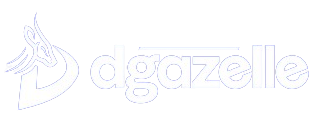Expert PPC Tips for Franchise Success: Your Ultimate Guide to Winning Local Markets in 2025

Unlock franchise growth with expert PPC strategies tailored for local markets. This guide covers keyword research, geo-targeting, smart budgeting, and ad optimization to help you drive traffic and boost ROI. Perfect for franchisors and franchisees looking to master pay-per-click advertising and win in competitive local search results.
Structure, systems, and secrets: How to Automate Your Digital Course Business in 5 Easy Steps Before It Overwhelms You.

> If your business depends entirely on your manual effort to function, it’s not a business—it’s a job. And a stressful one at that.
What you need is a system, not more hustle.
You need to step out of the technician role and into the true CEO role.
And that starts with automating and structuring your business like a real enterprise—one that can run even when you’re not glued to your screen.
Proven Smart Website Design in 2025: How to Turn Your Website Visitors into Paying Customers & Raving Fans
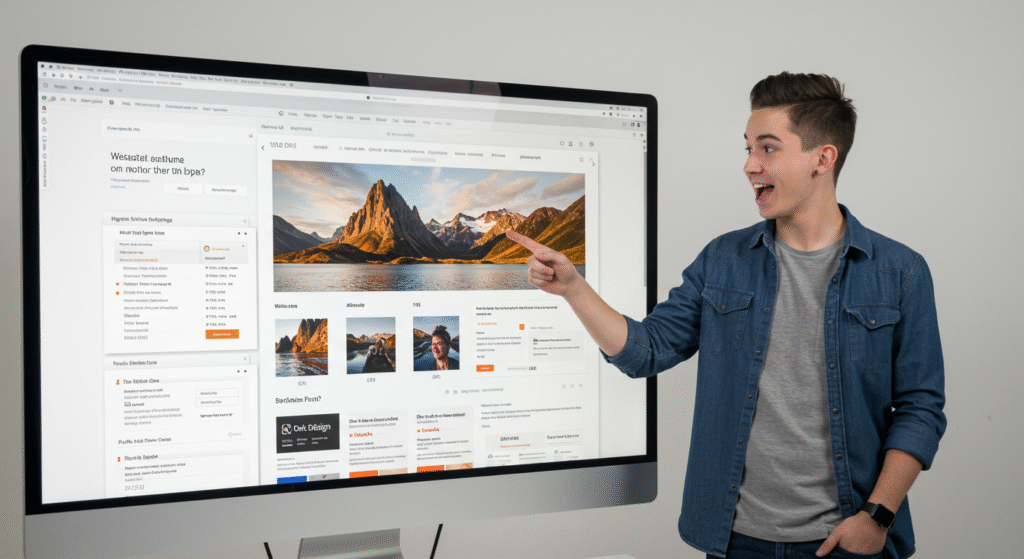
In today’s digital world, your website is often your first and most important salesperson. But here’s the thing: a good-looking website alone isn’t enough. If it doesn’t guide visitors toward action, you’re leaving money on the table. This blog shows you how to turn casual clicks into committed customers with smart, SEO-friendly website design in 2025. Whether you run an online store, service business, or personal brand, these tips will help you convert traffic into tangible results. Why Smart Website Design is Crucial in 2025 First impressions happen fast. Studies like this Stanford credibility study reveal that 75% of users judge a company’s credibility based on its website design. In 2025, competition is stiffer than ever, and users are more impatient. A slow, clunky, or confusing site won’t just lose visitors, it’ll lose revenue. At Dgazelle Digital Agency, we believe design is more than pretty visuals. It’s a business tool that guides visitors toward booking a call, purchasing a product, or signing up for a newsletter. Top 6 Design Tactics That Turn Clicks into Conversions Design isn’t just about looking good; it’s about guiding your visitors toward taking action. These six essential tactics focus on usability, clarity, and persuasion to help you turn casual website visitors into loyal customers. By applying these strategies, you’ll create a smoother user experience that boosts your conversion rates and drives business growth. 1. Clear and Consistent Navigation Your menu should be simple, not overwhelming. Users should know where to go without guessing. Limit navigation to 5–7 core items, and make sure your contact or CTA page is always visible. Example: Apple keeps its site navigation minimalist and focused, helping users find exactly what they need. 2. Mobile-First Design With over 60% of traffic now coming from mobile, your site must be thumb-friendly. Use responsive templates, test regularly, and avoid cluttered layouts. Run a quick test with Google’s Mobile-Friendly Test. 3. Speed is Everything If your site takes more than 3 seconds to load, users bounce. Compress images, eliminate unnecessary plugins, and optimize code. Use PageSpeed Insights to monitor performance. 4. Strategic CTAs (Calls-to-Action) Your site should guide visitors step-by-step. Use buttons like: Place CTAs above the fold and at the end of each section. Tip: Make CTAs a contrasting colour so they stand out from the rest of the design. 5. Trust Builders Social proof can boost conversions by up to 34%. Include: 6. SEO-Optimised Content Design and SEO must work hand-in-hand. Use your primary keywords naturally in: For example, if your focus keyword is “mobile-first design,” a well-optimised sentence could be:“Implementing a mobile-first design ensures your website performs perfectly on smartphones and tablets, improving user experience and boosting SEO rankings.” Beyond keywords, make sure your content is clear, useful, and easy to read. Google rewards sites that provide real value to visitors, so combine SEO best practices with great content to maximise your site’s performance. To learn more about combining SEO with smart design, check out Moz’s Beginner’s Guide to SEO. Image Source: Freepik Must-Have Pages for Maximum Conversion Your website isn’t just a digital brochure; it’s a sales engine. However, to convert visitors into leads or customers, certain pages must be present and built with a specific purpose. These core pages not only inform but also guide users through your sales funnel seamlessly. Whether you’re launching a new website or optimizing an existing one, start by getting these essentials right. Avoid These Common Mistakes Even with the best intentions, many websites lose potential customers due to simple design oversights. These mistakes can create friction in the user experience, reduce trust, and prevent conversions. By identifying and avoiding them early, you’ll make a smoother, more engaging site that delivers better results. Here are some common pitfalls to steer clear of: Enhance Engagement with Visual Hierarchy Visual hierarchy is the art of guiding your visitors’ eyes toward the most important elements on each page. By strategically placing headings, images, buttons, and whitespace, you can increase user engagement and improve conversions. Tip: Use larger fonts and bold colours for key messages, and keep secondary information less prominent. Check out Canva’s guide to visual hierarchy to better structure your layout. Integrate Live Chat and Chatbots Customer support no longer happens only through email. Live chat or AI-powered bots can answer questions instantly, remove buying hesitations, and boost trust. Tools like Tidio or LiveChat are easy to install and mobile-friendly. Want Your Website to Convert Better in 2025? Smart website design is no longer optional; it’s essential. To turn your traffic into sales, you need a conversion-driven approach. At Dgazelle Digital Agency, we don’t just design. We build websites that sell. 👉 Book a Free Website Audit and find out how to make your site work harder for your business.
5 REASONS Why Your E-commerce Funnel Is Not Converting the Right People — And How to Fix It
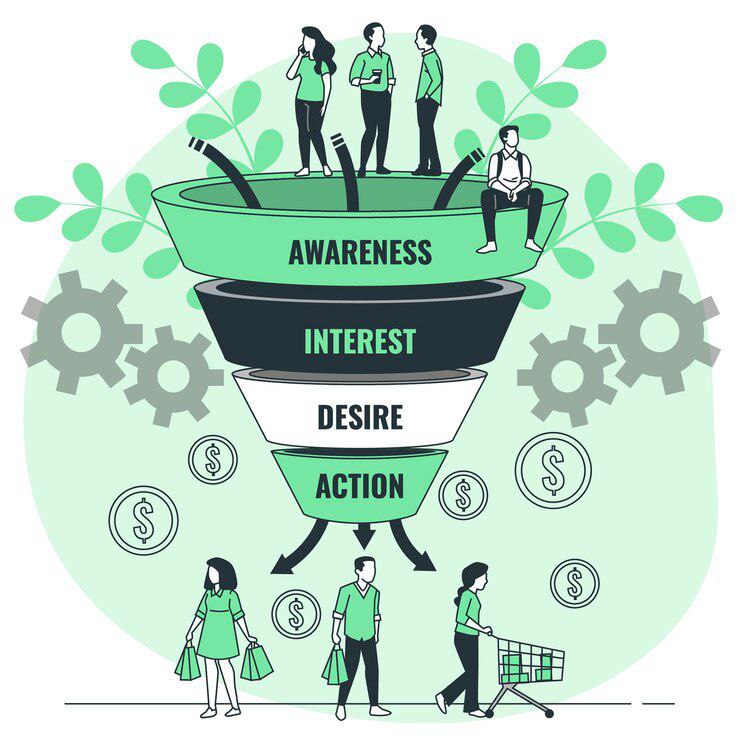
If you’re targeting everyone, you’re converting no one. Many e-commerce business owners run Facebook or Google ads with wide demographics, hoping to cast a large net. But broader targeting often results in attracting people who aren’t a good fit for your offer
Paid Ads That Convert: How to Run Effective Digital Advertising Campaigns Without Wasting Your Budget in 2025

Digital advertising has become one of the most effective ways to rapidly grow a business. If you want to reach new audiences, drive targeted traffic to your website, or promote your products and services without the long wait of SEO, running online ads can be a game-changer. But how do you ensure your campaigns are effective and don’t waste money? This guide breaks down how to run high-performing digital ad campaigns across platforms like Google, Facebook, and Instagram, no fluff, just proven insights. What Are Online Ads and Why Are They Important? Online advertising refers to placing promotional content on digital platforms to reach potential customers. These include: Unlike organic marketing, these campaigns offer instant visibility, allowing brands to target specific audiences and track results in real time. Some benefits of digital advertising: …paid ads are your shortcut to faster ROI (return on investment). And when done with the right strategy, they don’t have to be expensive. It’s about working smarter, not just spending more. Why Ad Campaigns Often Underperform Many businesses struggle with digital ads because they: Without a clear strategy, it’s easy to spend heavily without seeing a return. Avoiding these mistakes is key to building successful, scalable advertising campaigns. Proven Strategies for High-Performing Digital Ad Campaigns Here’s how to structure an online advertising campaign that gets results: 1. Start With Market Research Before creating ads, understand your audience. What are their needs, habits, and pain points? Tools like Google Trends, Google Keyword Planner, Meta Audience Insights, and Ubersuggest can help uncover key behaviours and opportunities. 2. Craft High-Quality Ad Creatives Visuals and copy make or break your campaign. Focus on: For example, instead of saying “Buy our skincare kit,” use “Struggling with acne? Get visible results in just 7 days.” 3. Use Targeting Wisely On platforms like Meta Ads Manager or Google Ads, you can target users based on: Proper targeting ensures your ads are seen by people most likely to take action. 4. Test and Optimize Frequently A/B testing helps identify what works. Test different headlines, formats, images, and calls-to-action. Monitor performance with tools like Google Analytics, Facebook Pixel, or Hotjar to understand where to optimize. Focus on metrics like: Want to learn more about optimizing Facebook campaigns? Check out Meta Blueprint. 5. Set a Smart Budget You don’t need to spend big to get results. Begin with a manageable daily budget and increase it based on performance. Focus spending on high-performing ad sets and pause what’s underperforming. 6. Use Retargeting Only 2% of people convert on the first visit. Use retargeting ads to bring back visitors who didn’t take action the first time. This tactic is especially effective with abandoned cart campaigns, event reminders, or lead magnets. Top Platforms for Digital Advertising Image Source: Freepik Here’s a quick overview of where to run your campaigns: Common Myths About Online Advertising (Debunked) “Paid ads are too expensive.”Not true. When done right, even small budgets can bring great results. “I tried it once and it didn’t work.”Most likely, the strategy was off. It’s not about luck. It’s about testing and optimization. “My business isn’t big enough for ads.”Paid ads work for any size. Whether you’re selling a product, offering a service, or launching a course, paid ads can help you reach the right people. “Just boosting a post is enough.” Boosting is not the same as a full ad campaign with strategy and tracking. Combining Organic Marketing With Paid Ads Paid campaigns bring immediate traffic, while SEO and content marketing build long-term trust and authority. When used together: Think of SEO as the long game, and paid ads as your shortcut. Together, they create a full-funnel strategy that brings in traffic, nurtures leads, and drives conversions. Want Expert Help With Your Ad Campaigns? Running successful ad campaigns takes expertise, data, and continuous improvement. If you want to skip the guesswork and get real results, the team at Dgazelle Digital Agency can help. 👉 Book a Free Paid Ads Strategy Session to start growing your business with smart advertising.
Email Isn’t One-Size-Fits-All, Turn Data into Dialogue with Better Email Segmentation
Email remains one of the most effective channels for reaching and engaging customers. Yet, if you’re blasting the same message to your entire list, you’re missing out on the true power of email and that is email personalization. The days of “one-size-fits-all” campaigns are over. To stand out in crowded inboxes and drive real business results, you need to turn data into dialogue through smart email segmentation. Let’s read on to find out why segmentation matters, how to do it right, and how it can transform your email marketing ROI. Plus, discover how our web design and digital marketing services can help you build a smarter, more profitable email strategy. Why “One-Size-Fits-All” Email Fails Modern Businesses Generic email blasts might have worked a decade ago, but today’s consumers expect more. Research shows that 80% of customers want personalized experiences from brands, and 56% unsubscribe from emails that feel irrelevant. If your emails don’t speak directly to your recipients’ needs, you risk being ignored—or worse, marked as spam. The Cost of Irrelevance Email segmentation is the solution to these problems. By dividing your list into targeted groups, you can send the right message to the right person at the right time turning data into meaningful dialogue. What Is Email Segmentation? Email segmentation is the practice of splitting your email list into smaller groups based on shared characteristics—such as demographics, behavior, purchase history, or preferences—so you can deliver content that’s relevant to each segment. Think of segmentation as moving from shouting in a crowded room to having one-on-one conversations. The result? More engagement, higher conversions, and stronger customer relationships. Want to see higher open and click rates? Discover how our web design and digital marketing experts can transform your email strategy today The Business Benefits of Email Segmentation Segmentation Strategies That Work There’s no single “right” way to segment your list. The best approach combines multiple data points for a nuanced, audience-centric strategy. Here are proven segmentation methods tailored for business owners: 1. Demographic Segmentation: Segment by age, gender, location, occupation, or income to tailor offers and content. For example, a retail brand might send different promotions to customers in cold vs. warm climates, or a B2B firm might segment by industry or company size. 2. Behavioral Segmentation: Track how subscribers interact with your brand—purchase history, website visits, email opens, and clicks. Reward your most engaged subscribers with VIP offers, or re-engage those who haven’t opened your emails in a while. 3. Psychographic Segmentation: Go beyond surface-level data to segment by interests, values, or attitudes. For instance, highlight eco-friendly products to sustainability-minded customers, or promote luxury items to those who value exclusivity. 4. Lifecycle Stage Segmentation: Not all customers are at the same stage. Welcome new subscribers, nurture leads, reward loyal buyers, and win back lapsed customers with tailored messaging at every step. 5. Purchase History & Content Preferences: Send recommendations based on what customers have bought or browsed. If someone purchased running shoes, follow up with related gear or exclusive content about running. 6. Engagement Frequency: Some subscribers want daily updates, others prefer weekly digests. Let users set their preferences, or segment based on observed engagement patterns to avoid overwhelming your audience1. 7. Micro-Segmentation for Hyper-Personalization: Take segmentation further by targeting ultra-specific behaviors—like cart abandoners, high-value customers, or users who clicked a specific link in your last campaign. The more relevant your message, the higher your results1. How to Implement Effective Email Segmentation Don’t let your messages get lost in the inbox. Contact us to create personalized, high-converting emails tailored to every segment of your audience. Common Segmentation Mistakes to Avoid Turning Data into Dialogue: The Human Side of Segmentation Segmentation isn’t just about numbers—it’s about building relationships. When you use data to understand your audience’s needs, preferences, and behaviors, your emails feel less like marketing and more like a conversation. This fosters trust, loyalty, and long-term value. Ready to turn your email list into your most valuable business asset? Let Dgazelle help you transform data into dialogue and drive real growth with smarter segmentation. Conclusion Email isn’t one-size-fits-all. It’s a dynamic, data-driven dialogue between your business and your customers. By embracing segmentation, you’ll send emails people actually want to read—boosting engagement, conversions, and loyalty. Don’t settle for generic campaigns or wasted marketing spend. With the right strategy and the right partner, you can unlock the full potential of your email list. Personalized communication isn’t the future of email—it’s the present. Start segmenting, start connecting, and watch your business grow.
Vanity Metrics: Are You Tracking What Truly Matters?
If your website pulls in loads of traffic each month, it’s tempting to think your business is thriving. But here’s the catch: traffic without meaningful conversions is just noise. As exciting as big numbers may look, they don’t always tell the full story or help you grow. Many startups and small business owners fall into the trap of tracking what’s easy instead of what’s effective. Metrics like pageviews, social media likes, and impressions feel good but often do little for your bottom line. In his article “Run Away from Vanity Metrics,” Ivan Bjelajac hits this nail on the head by reminding us that what we track shapes how we act. At Dgazelle, we believe real success lies in understanding the right data. That’s why our web design approach prioritizes clarity, user flow, and conversion—not just flashy numbers. What Are Vanity Metrics? Vanity metrics are numbers that may look good on paper but don’t impact your bottom line, growth, or strategic decision-making. They often inflate your sense of success without offering insight into what’s actually working. Most business owners understand that tracking results is essential to measuring success. But here’s where many go off track they start measuring the wrong things. It’s easy to download a shiny analytics tool or plug into a fancy dashboard that shows you numbers like user count, social shares, or monthly traffic. Feels great, right? Gives you a sense of control and progress. But be careful—that feeling can be deceptive. Metrics like “1 million pageviews” or “10,000 app downloads” look impressive but often don’t help you take meaningful action. They’re good for feeling awesome, but bad for decision-making. Even Monthly Recurring Revenue (MRR) can be misleading if you don’t understand why it’s growing or who your loyal customers are. At Dgazelle, we always ask: what action does this metric inspire? If it doesn’t tell a story or lead to a next step, it’s just vanity. And in business, vanity doesn’t pay the bills. How to Identify Vanity Metrics The simplest way to spot a vanity metric is to ask yourself: “So what?” If an increase in a metric doesn’t lead to a clear next step or business outcome, it’s likely vanity. For example, if your website traffic doubles but sales remain flat, the traffic increase is probably a vanity metric. Similarly, if your social media followers grow but engagement and conversions don’t, that follower count might not be meaningful. Another red flag is if a metric can be easily manipulated without improving your business—like buying followers or running ads that boost impressions but don’t generate leads. You’d be surprised how transformative a simple question—“Why?”—can be. In Aristotelian philosophy, the term cause refers to the explanation behind a “Why?” question. This principle is essential when making strategic business decisions. Too often, we make decisions based on surface-level data, without digging deeper into what truly drives those results. Let’s apply the 3 Whys to better understand the cause of your revenue: Now, instead of focusing directly on revenue, shift your focus to measuring the success rate of your feature. When you understand what drives your sales, revenue will naturally follow. The key is to look beyond vanity metrics and focus on actionable data. At Dgazelle, we help businesses identify what truly matters through data-driven web design and strategies, so you can stop guessing and start growing. Common Vanity Metrics and Why They Can Mislead You Many popular metrics fall into the vanity category if not interpreted carefully. Here’s a breakdown of some frequent offenders: 1. Impressions Why it’s vanity: Impressions tell you how many times your ad or content was displayed, but not if anyone cared or took action. When it matters: For brand awareness campaigns or retargeting strategies, impressions paired with engagement metrics can be useful. 2. Pageviews Why it’s vanity: More pageviews don’t guarantee conversions. Visitors might be bouncing or bots could inflate numbers. When it matters: Tracking pageviews on key conversion pages (pricing, checkout) and linking them to conversions can be insightful. Stop wasting time on vanity metrics. Lets work together and implement data-driven marketing strategies that attract qualified leads and maximize your ROI. 3. Site Traffic Why it’s vanity: Traffic spikes look good but mean little if visitors don’t engage or convert. When it matters: When traffic comes from high-intent sources like organic search for relevant keywords. 4. Time on Website Why it’s vanity: Longer time might indicate confusion rather than interest. When it matters: When combined with engagement signals like scroll depth or clicks on calls to action. 5. Bounce Rate Why it’s vanity: High bounce isn’t always bad; it depends on page purpose. When it matters: For product or landing pages, a low bounce rate is better. For blog posts, a high bounce might be normal. Here’s a refined version of that section, optimized for SEO and tailored to business owners, with a subtle pitch for Dgazelle’s services: Measure What Truly Matters For startups, it’s vital to track the right data to understand the true health of your business. Focus on metrics that genuinely guide decision-making and drive growth. Metrics like the number of visitors, subscribers, or followers may look good on paper, but if they don’t align with your goals, they’re just vanity metrics. Instead, concentrate on data that you can act on. For example, tracking page views without addressing a high bounce rate won’t improve user engagement. Similarly, having 10,000 followers who don’t engage with your content doesn’t contribute to your business goals. By measuring what truly matters, such as user interactions, conversion rates, and customer retention, you can make more informed decisions that will help your business grow. If you need help creating a data-driven website that focuses on metrics that matter, Dgazelle’s expert web design services can help optimize your site for better user experience and meaningful results. Metrics That Truly Matter for Your Business Growth To grow sustainably, focus on actionable metrics that guide decisions and tie directly to revenue and profitability. Click-Through Rate (CTR) CTR
Outbound Marketing: How to Do It & Why It Matters
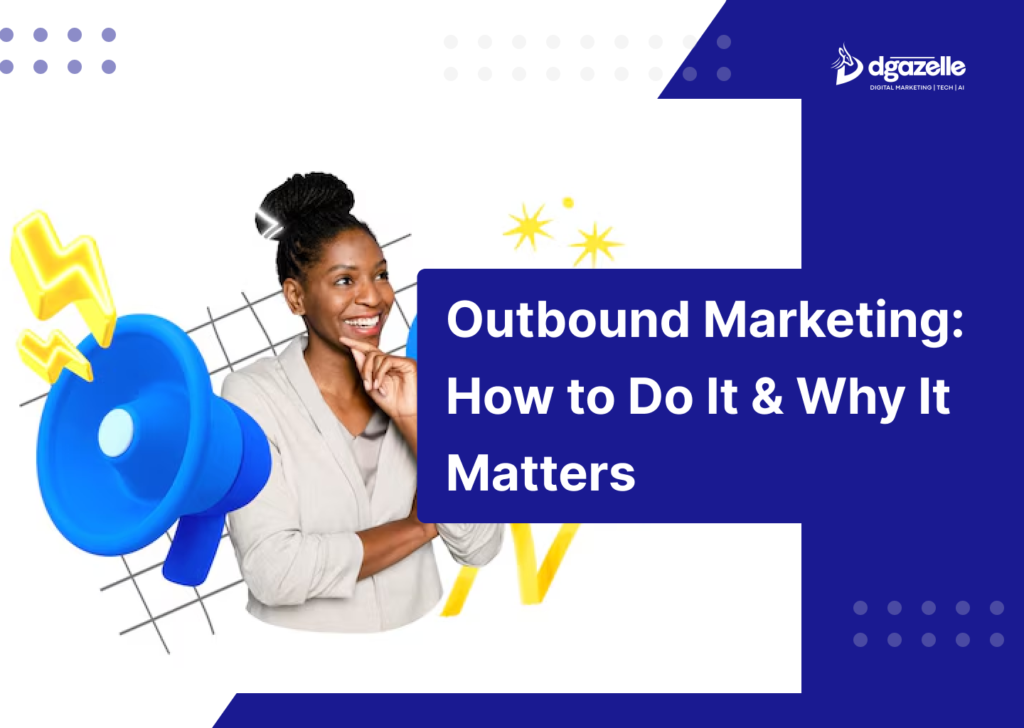
Outbound marketing is a proactive strategy where businesses reach out to potential customers rather than waiting for them to discover their brand. This includes traditional methods like TV commercials, radio ads, cold calls, and billboards, as well as digital approaches such as email marketing, influencer collaborations, paid social media ads, and retargeting campaigns. Unlike inbound marketing where customers find your business through content like blogs or SEO outbound marketing pushes your message to a broad audience, sometimes interrupting their daily activities. That’s why it’s often called “push marketing” or “interruption marketing.” However, when done right, outbound marketing helps businesses build brand awareness, engage the right audience, and drive sales. The key is strategic execution choosing the right channels, refining your message, and ensuring your brand appears in front of the right people at the right time. For Nigerian businesses, a well-crafted outbound marketing campaign, paired with a high-converting website can be a game changer. That’s where Dgazelle’s web design services come in. A well-optimized website makes your outbound efforts more effective by ensuring your ads drive traffic to a professional, high-performing online presence. Why Outbound Marketing Is Important Inbound marketing is powerful, but let’s be real—if people don’t know your product or service exists, they won’t search for it. Outbound marketing ensures your business gets in front of the right audience, whether they’re actively looking or not. Here’s why outbound marketing still matters for Nigerian businesses: For the best results, combine outbound efforts with a strong online presence. A high-converting, well-optimized website—like those crafted by Dgazelle—ensures that your outbound traffic turns into paying customers. Outbound Marketing Strategies Success in marketing isn’t about using just one strategy—it’s about a mix of tactics that help you reach your target audience at different touchpoints. Here are five outbound marketing strategies that can boost your brand’s visibility and customer engagement in Nigeria. 1. Cold Email Cold emails can feel intrusive, but when done right, they’re a powerful lead-generation tool. The key is personalization. Instead of generic pitches, craft emails that offer real value, address specific pain points, and show how your solution fits their needs. 2. Search Ads Paid search ads place your business in front of potential customers at the right moment. Whether it’s Google Ads or Bing Ads, search advertising delivers instant visibility, measurable ROI, and high-intent traffic to your website. 3. Social Media Ads With social media usage soaring in Nigeria, platforms like Facebook, Instagram, and TikTok offer cost-effective paid advertising. Since organic reach is declining, investing in social media ads ensures your brand stays visible, engages your audience, and drives conversions. From cold emails to paid ads, we create outbound campaigns that convert. Elevate your brand’s visibility and drive real growth. Start Your Campaign Now! 4. Outreach Marketing Reaching out to the right influencers, industry leaders, and media outlets boosts credibility and brand awareness. Whether it’s through email outreach, PR campaigns, or influencer partnerships, this approach helps build trust and authority in your industry. 5. Content Syndication Repurposing content on platforms like Medium, LinkedIn, and Quora extends your reach beyond your website. Paid syndication tools like Outbrain help push your content to larger audiences, maximizing visibility. Pro Tip: No matter which outbound strategy you choose, your website must be optimized for conversions. Dgazelle helps businesses create high-performing websites that turn traffic into customers. 6. Trade Shows & Events While digital marketing dominates today’s landscape, in-person events still hold value. Attending trade shows and industry events puts your brand directly in front of a highly targeted audience. For example, Nigerian businesses in real estate can leverage property expos, while tech startups can attend industry conferences to network and generate leads. To maximize ROI, track event metrics like footfall, lead capture, and conversions, then follow up with personalized emails. 7. Cold Calls Cold calling may seem outdated, but it remains effective. The key is shifting from pushy sales scripts to meaningful conversations. Strategies like SPIN selling—where you ask prospects structured questions to uncover their pain points—can improve success rates. 8. Traditional Media Advertising Despite the rise of digital marketing, TV, billboards, radio, and print ads still drive brand awareness. Nigerians still consume traditional media heavily, making it a great complement to online efforts. Pro Tip: Ensure your digital presence is strong. Dgazelle creates websites optimized for conversions, ensuring every outbound lead has a seamless experience. Merging Inbound and Outbound Marketing As we detailed earlier, there are some main differences between inbound and outbound marketing. Inbound marketing is when a customer comes to you first, and outbound is more about pushing your message to potential leads, but the two can work together. For example, people might sign up for your mailing list or a white paper, but you start the conversation with an outbound marketing strategy through advertising, cold calling, or email. Although they’re very different strategies, you can mix them up to reach more people by: Conclusion: Why Outbound Marketing Still Matters Marketing is competitive, and waiting for customers to find you isn’t always enough. Outbound strategies usually cold emails, search ads, social media ads, trade shows, and traditional media help boost visibility and drive engagement. Outbound marketing remains relevant today, complementing inbound efforts to strengthen brand growth. However, the key is understanding your audience and delivering value. When done right, outbound marketing becomes a powerful tool in your overall strategy. Don’t just wait for customers to find you—put your brand in front of them! Let’s craft an outbound marketing strategy that drives results. Get a Free Strategy Session Today!
From Tales by Moonlight to TikTok: The Power of Nostalgia Marketing in Modern Nigerian Marketing
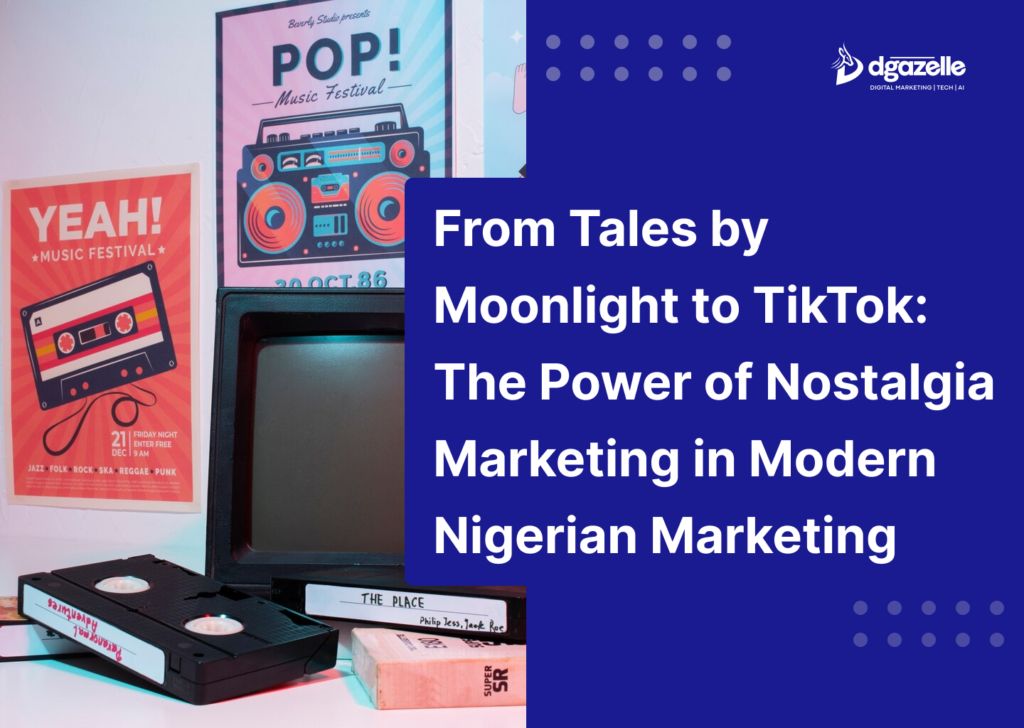
Ever found yourself smiling at an old commercial jingle or reminiscing about Tales by Moonlight? That’s nostalgia marketing at work! It taps into deep emotions linked to cherished memories, instantly creating a bond between your brand and your audience. But nostalgia marketing is more than just a sentimental trip down memory lane—it’s a powerful tool to drive engagement, loyalty, and sales. Nigerians love nostalgia, whether it’s the music of Plantashun Boiz, Super Story reruns, or childhood snacks like Baba Dudu and Goody Goody. As a small business, you can tap into these collective memories to connect with your audience in an authentic and emotionally compelling way. Let’s explore how nostalgia marketing works and why it’s a game-changer for Nigerian brands. What Is Nostalgia Marketing? Nostalgia marketing is a strategy that connects your brand to past memories, creating an emotional bond with your audience. It taps into shared experiences—whether it’s childhood TV shows, classic snacks, or old-school fashion trends—to spark feelings of joy and familiarity. Think of how Nigerians light up when they hear Tales by Moonlight mentioned or see a pack of Okin Biscuit. That’s nostalgia in action! Big brands use this by bringing back retro packaging (like Coca-Cola’s classic bottle design) or reviving old-school trends. For Nigerian small businesses, nostalgia marketing can be a game-changer. Whether it’s referencing old Nollywood films, vintage Naija pop culture, or throwback slang (way back when “No wahala” was the go-to phrase!), you can use nostalgia to create content that resonates deeply with your audience. Why Does Nostalgia Marketing Work? Nostalgia marketing is powerful because it offers comfort and familiarity, especially in uncertain times. It transports people to the “good old days,” providing a sense of stability and joy. Research even suggests that nostalgia helps with emotional well-being, making people feel more connected and secure. For Nigerian small businesses, nostalgia marketing is an opportunity to tap into shared cultural moments. Whether it’s the days of Papa Ajasco, Superstory, or the original MTN “Y’ello” commercials, these memories trigger strong emotions and connections. Nostalgia is also social—it creates conversations, bonding people over collective experiences. Even though nostalgia feels personal, it has mass appeal. When a campaign reminds people of their childhood snacks (Gala and La Casera, anyone?), school days, or early social media experiences (2go and Facebook pokes!), it resonates deeply. It builds trust, strengthens brand loyalty, and—when done right—translates into higher engagement and sales. Want to craft a nostalgia marketing campaign that resonates? Our digital marketing experts help brands connect with audiences through emotional storytelling. Let’s create your winning strategy today How Does Nostalgia Marketing Work? Nostalgia marketing taps into deep emotions, triggering feelings of joy, security, and familiarity. When people recall the “good old days,” they associate those memories with happiness—creating a powerful emotional bond with a brand. For Nigerian Millennials and Gen X, nostalgia feels like comfort food for the brain. In a rapidly changing, often chaotic world, throwbacks to simpler times (remember when Nokia 3310 was king?) offer a welcome escape. Research even shows that nostalgia boosts emotional satisfaction, increasing brand loyalty and spending. Beyond personal memories, nostalgia is social. A shared love for Tales by Moonlight or Super Strikas creates instant community. To tap into this, brands can use: By incorporating these, small businesses can create campaigns that resonate emotionally, boosting engagement and conversions. Tips for Implementing Nostalgia Marketing Nostalgia marketing can help brands create an emotional connection with their audience. Here are practical ways to incorporate it effectively: 1. Know Your Audience To trigger nostalgia successfully, you must understand your target audience and their emotional connections to the past. Different generations have distinct cultural references that resonate with them. To refine your approach, research: Example: A Nigerian fashion brand targeting Millennials could bring back bootcut jeans and Rocawear-inspired outfits, while a beverage company could revive classic soft drink packaging. Nostalgia is powerful—but only when done right. Our agency combines data-driven insights with creative storytelling to boost engagement and conversions. Let’s bring your brand’s past to life! 2. Leverage Social Listening People constantly share nostalgic moments online. By tracking these conversations, brands can identify trending nostalgic topics and incorporate them into marketing campaigns. How to stay ahead of nostalgia trends: Example: If “Palm wine tapper movies” trends in Nigeria, a beverage brand could create content referencing Sam Loco Efe or Aki and Pawpaw to connect with older audiences. 3. Tap Into Company History If your company has been around for a while, revisiting past branding elements can stir nostalgia and attract both new and returning customers. Ways to leverage brand history: Example: Fan Milk Nigeria recently revived its Fan Ice branding, triggering nostalgia among Nigerians who grew up buying it from street vendors. Conclusion Nostalgia marketing is a powerful tool, but it requires a thoughtful approach to be truly effective. It’s not just about using retro visuals or catchy throwback references—it’s about strategically tapping into the emotional connections your audience has with the past. To create an impactful nostalgia-driven campaign, start by identifying the cultural moments, trends, and experiences that shaped your target audience. Whether it’s a particular song, a childhood snack, or a vintage tech gadget, these elements should evoke a sense of familiarity and comfort. However, nostalgia should not feel outdated; instead, it should be reimagined in a way that resonates with today’s consumers. The key to success is balance: blending the past with the present to create something fresh yet familiar. When done right, nostalgia marketing fosters engagement, strengthens brand loyalty, and turns sentimental memories into meaningful connections that drive action. Reimagine the past with a fresh twist! We design nostalgia-infused campaigns that spark emotions and drive results. Let’s make your brand unforgettable.
Marketing Budget Crisis? 7 High-Impact Strategies That Cost Nothing

For small businesses, every Naira counts. Marketing on a tight budget requires creativity and smart strategies to maximize your resources without sacrificing effectiveness. The great news? There are several low-cost strategies that can help you reach your target audience and increase engagement without breaking the bank. As Nigerian SMEs, we understand that both time and money are limited resources. That’s why we’ve put together a list of practical, budget-friendly tactics that are not only easy to implement but also incredibly impactful. Whether you’re just starting your business or looking to refresh your marketing approach, these strategies will help you make the most of your marketing spend and grow your business—no matter the size of your budget. In fact, The CMO Survey revealed that 42% of Chief Marketing Officers (CMOs) are dealing with marketing budget cuts. But despite these challenges, businesses are still finding ways to adapt and thrive with cost-effective solutions. This article dives into the most effective strategies for Nigerian business owners who are navigating budget constraints, helping you make every Naira you spend work harder for your business. Marketing budget and Clear Marketing Goals When you’re facing a marketing budget crunch, setting clear goals and priorities becomes a game-changer. It’s about making every Naira work harder for you. Rather than spreading your resources thin across various activities, you need to laser-focus on what truly matters to drive growth and success. So, how can you set the right marketing goals for your business? Here’s a step-by-step guide: Focusing on high-impact, low-cost activities is key to achieving maximum results. At Dgazelle, we help businesses refine goals, target the right audience, and streamline processes to make the most of limited marketing budgets. Reach out today to start optimizing your strategy! 1. Leverage Social Media Platforms Social media is a powerful, low-cost marketing tool that allows you to reach a wide audience. Platforms like Instagram, Facebook, Twitter, and LinkedIn offer free accounts for businesses to build their presence and engage with their audience. By consistently posting valuable content, responding to customer inquiries, and using hashtags effectively, you can gain traction without spending a penny. You can also join relevant groups or communities to increase visibility and engage with your target audience directly. 2. Create Valuable Content Creating valuable content is a powerful way to attract new customers and position your business as an authority in your industry. Whether it’s blog posts, e-books, whitepapers, or videos, providing useful and relevant information will keep your audience engaged. The best part? It’s cost-effective and builds long-term value. By consistently sharing this content on your social media platforms and website, you increase visibility and drive organic traffic. To make the most of your content, balance between gated (premium) and non-gated (free) content. Gated content allows you to capture leads, while non-gated content nurtures broader engagement and establishes trust. Whatever approach you chose to use, ensure to optimize your content for SEO with simple practices like using keywords, internal linking, and creating shareable content. Or better still outsource it to dedicated marketing agency like Dgazelle 3. Email Marketing Email marketing remains one of the most powerful tools for small businesses on a tight budget. By building an email list and sending regular, valuable content to your subscribers, you can nurture relationships and drive repeat business. Platforms like Mailchimp offer free plans for small lists, which means you can get started without any upfront cost. Use segmentation to send personalized, targeted messages to different parts of your audience to increase open and click-through rates. 4. Collaborate with Influencers (Micro-Influencers) While working with big influencers might be out of reach, micro-influencers (those with smaller, highly engaged followings) often offer affordable or even free collaboration opportunities. Micro-influencers are typically open to partnerships in exchange for free products, services, or exposure. This tactic can help you tap into a new audience and build credibility at little to no cost. Remember to choose influencers whose followers match your target demographic to maximize the effectiveness of your campaigns. 5. Offer Discounts and Promotions Offering discounts and promotions is a highly effective way to attract new customers while encouraging repeat business. Whether it’s a special discount for first-time buyers or a loyalty program for returning customers, these offers can motivate potential customers to take action and increase retention. Promotions are also a great way to generate urgency and boost sales, especially if you time them with holidays or special events. Loyalty programs, on the other hand, help build long-term relationships with customers, fostering brand loyalty and increasing the lifetime value of each client. At [Dgazelle Digital], we understand how impactful these strategies can be, and we can help you design the perfect promotions and loyalty programs that align with your business goals. By offering the right incentives, you not only attract new customers but also ensure they keep coming back, all while working within your budget to maximize returns. 6. Referral Programs A referral program can be an incredibly cost-effective way to increase your customer base. By offering existing customers incentives (such as discounts or freebies) for referring others, you can generate new leads with minimal investment. Word-of-mouth marketing remains a powerful tool, especially when customers are motivated by rewards. Ensure to keep the process simple and the reward is attractive enough for customers to want to participate. 7. Networking and Partnerships Networking and building partnerships with other small businesses or professionals in your industry can open doors to valuable marketing opportunities. Attend local events, participate in online forums, and collaborate with businesses that complement your products or services. By sharing each other’s audiences, you can expand your reach without spending any money. You can use LinkedIn to connect with potential business partners and influencers in your industry. Conclusion Marketing on a tight budget doesn’t mean you have to compromise on quality or effectiveness. By leveraging these strategies, small businesses can make the most of their limited resources and still drive significant growth. Whether it’s through organic social media marketing, content creation, or
